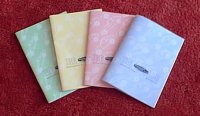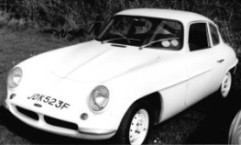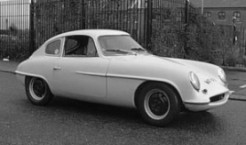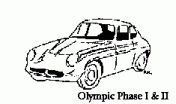
Welcome :
The Rochdale Owners Club was formed in June 1981 by a group of owners keen to establish a club exclusively for the Rochdale marque.
The Rochdale Olympic Phase I & II
The Olympic represented a huge step forward from anything Rochdale Motor Panels had built before, and its existence is largely down to one man: Richard Parker. His first contact with Rochdale was in 1955 when he was purchasing some glassfibre to make a special body for an Austin Seven; later he became involved in creating the GT. While he was waiting to take up a postgraduate apprenticeship at the Bristol Aircraft Company, he was asked to join the company. At this time Rochdale was still building the GT and there were many discussions on the way the market was heading and what kind of car they should develop next. Pooling their skills, Parker's Engineering degree and Smith and Butterworth's knowledge of manufacture of their earlier bodies, they realized that they could build a bodyshell strong enough to do without a chassis frame. Simple sketches were drawn of the car's proposed styling and then photos were taken from different parts of cars that the team found appealing. A fundamental requirement of the design was that it should be aerodynamic, to gain the best performance from whatever engine was used.
At the time Richard's father had an early Porsche and this had a significant influence on the final shape of the Olympic, though styling cues can also be seen from the GT and Riviera models. With the basic styling agreed, plaster shapes were made, sections being scrapped or modified until the definitive Olympic design emerged. Meanwhile Richard had joined Bristol where he would remain until Smith asked him to join Rochdale permanently.
When Richard returned, RMP had almost completed the mould for the first prototype. The prototype body was laid up and work began on constructing the car. It had been agreed to use components from the Morris Minor (solid rear axle, torsion bars at the front and a BMC A-series power train) as they were simple, strong, cheap and readily available. The prototype tested at over 85mph despite its meagre engine power, illustrating the aerodynamic qualities of the body.
Development on the prototype continued well into 1960 with the car covering 30,000 miles, during which time details were finalised for the production version and another mould was prepared, incorporating larger windows and a purpose made, highly curved windscreen. The success of the Riley 1.5, using Morris Minor-derived running gear, led to a swift switch that gave the Olympic 105mph performance. Most production cars had the Riley 1.5 engine, though Minor, MGA, Ford 100E and 105E were also fitted and one left the factory with a Coventry Climax racing engine.
Road testers raved about the Olympic. In a first test of the well-used prototype, The Motor wrote: "Driving the prototype emphasised the rigidity of the construction, none of the body shake often found in glassfibre specials being evident. There was very little wind noise and the top speed was commendably high." Full road tests of the production Riley 1.5-powered car sold as a complete kit of parts for £670 which it was claimed could be assembled in 48 hours but which, in fact, took many people 48 days or more were equally positive. Performance figures of 0-60mph in 11.7 seconds and 102mph maximum (limited by gearing) were recorded with a 60bhp engine which also gave fuel consumption of over 40mpg.
The Phase I took its front suspension from the Morris Minor or Riley 1.5: a torsion bar system with rack and pinion steering that was regarded as one of the best around at the time. On the Rochdale, the Minor's tie bars are replaced with an anti-roll bar, which provides location as well as roll restraint. At the back end, the Minor's leaf springs are rejected in favour of radius arms and telescopic spring/damper units, which locate the back axle very effectively. Handling is one of the Olympic's strongest points: its engine is set well back so the weight distribution is excellent and cornering is very neutral with little roll and good throttle control.
The front suspension, steering and engine mountings are carried on a steel tubular subframe which is bonded to the inner wings and floorpan, while the rear suspension and the gearbox mountings bolt directly into the glassfibre body without any steel reinforcements. High stress points were identified during the car's development and extra layers of glassfibre used there, so that the body's thickness varies throughout from around 2mm in areas like the centre of the doorskin to 10mm or more where the radius arms bolt to the body. The only other steel in the body is a roll hoop built into the windscreen surround, which makes it strong enough to roll over several times without damage to the glass just some crazing to the roof, as a few owners have proved!
Rochdale's position in the forefront of Ford Special production ended abruptly with a disastrous factory fire in February 1961, which destroyed the building and all the moulds inside it. This terrible setback came at a time when a great deal of money had been sunk into the development of the Olympic, which had just received rave press reviews. Rochdale was forced to abandon all the early models and concentrate exclusively on getting the Olympic back into production. It took months, during which many orders were lost.
The Rochdale team didn't rest on their laurels, introducing the Phase II Olympic at the start of 1963 with a Ford Cortina 1500GT engine and redesigned suspension all round, now Triumph-derived at the front and incorporating disc brakes. There was an electric cooling fan, windscreen washers were standard and the GRP thickness was reduced, which reduced the body weight by 1cwt. A hatchback made luggage access easier and performance from 78bhp was 0-60mph in 11.2sec and a maximum of 115mph. The price for the new kit was now £735, or the car could be purchased ready-assembled for £930.
But behind the scenes, Frank and Harry were getting fed up with the hassles of being car manufacturers, sourcing all the components, and dealing with the inevitable customer complaints when they couldn't fit the bits together (virtually all Olympics were sold as kits). Richard Parker had been poached by Lotus and in retrospect, they had priced the Olympic too low and couldn't afford to improve the quality. They found a profitable sideline in making heating ducting, which gradually turned into their primary business.
In all, some 250 Phase I and 150 Phase II cars were built, almost all by 1967 though the car was theoretically still available in the early 1970s. The last Olympic bodyshell was turned out (after a lot of effort to persuade them to make it) in 1973 and a few years later the moulds were sold to a group of Rochdale owners who still preserve them.
Copyright © Malcolm McKay - Early Rochdales Registrar
Copyright © Rochdale Owners Club
Last Update






